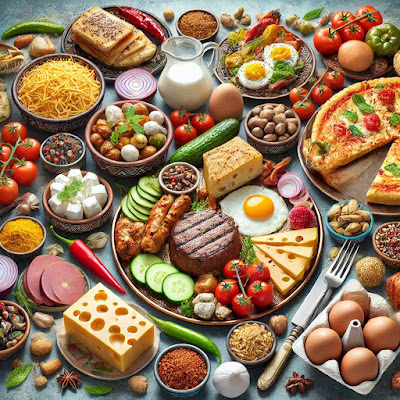The Power of Grains: Nourishing the Body and Mind Through the Teachings of Islam and Modern Science
Grains: Nourishing the Body and Mind through Timeless Wisdom and Modern Science
Grains in the Qur'an and Hadith
Grains have been a cornerstone of human nutrition for millennia, providing essential nutrients and energy. The Qur'an and Hadith emphasize their significance, highlighting their role in sustenance and health. As Surah Ya-Sin, verse 33, states:
"There is a sign for them in the dead earth: We give it life, producing grain from it for them to eat."
QURAN
This verse underscores the vital role of grains in human sustenance and the divine wisdom in their creation.
Grains in Islamic Teachings
The Prophet Muhammad (PBUH) emphasized the importance of grains in his teachings. He recommended barley and wheat as beneficial for health, particularly for heart health. From Shia sources, Imam Ali (AS) said:
"Barley bread is the food of the prophets and the pious."
ABOUT ISLAM
This highlights the esteemed status of barley as a food that nourishes both the body and soul, reflecting the importance of grains in daily life.
Scientific Perspective on Grains
Modern science has long recognized the health benefits of grains, particularly whole grains, which are rich in carbohydrates, fiber, vitamins, and minerals. Grains like oats, barley, and wheat help improve digestion, reduce the risk of heart disease, and promote weight management.
Studies suggest that consuming whole grains regularly can enhance cognitive function, lower cholesterol levels, and promote a healthy gut microbiome.
MEDICAL NEWS TODAY
Recommended Grain Consumption Ratio
While the Qur'an and Hadith do not specify a precise ratio for grain consumption, Islamic teachings emphasize balance and moderation in all things. A balanced diet often includes a variety of food groups. Incorporating grains as a significant portion of daily intake aligns with their nutritional importance.
Based on the concept of a balanced diet and the teachings of moderation, grains should take a central role in our meals. A proposed ratio for grain consumption could be 3:2:1—grains (3), vegetables (2), and proteins (1)—to ensure optimal nutrition and spiritual harmony.
List of Common Grains
Here are some common grains and their nutritional benefits:
Wheat
A staple grain used in bread, pasta, and various baked goods. Rich in fiber and B-vitamins, wheat supports digestive health and provides sustained energy.Rice
A primary food source in many cultures, available in white, brown, and wild varieties. Brown rice, in particular, is high in fiber and supports digestive health.Barley
Often used in soups, stews, and as a base for malt in beverages. Barley is rich in antioxidants and supports heart health.Oats
Commonly consumed as oatmeal or used in baking. Oats are high in soluble fiber, which helps reduce cholesterol and improve heart health.Corn
Consumed as cornmeal, popcorn, or in various dishes. Corn provides energy and is a good source of antioxidants and essential minerals.Quinoa
A complete protein source, quinoa contains all nine essential amino acids, making it a highly nutritious grain.
Grain Oils and Their Nutritional Values
Grain oils, extracted from the seeds of various grains, provide essential nutrients. Here are some grain oils and their benefits:
Corn Oil
High in polyunsaturated fats, particularly omega-6 fatty acids, and vitamin E, corn oil supports heart health.
MEDICAL NEWS TODAYRice Bran Oil
Contains monounsaturated fats, vitamin E, and antioxidants, making it beneficial for heart health and reducing inflammation.Wheat Germ Oil
Rich in vitamin E, omega-3 fatty acids, and antioxidants, wheat germ oil helps maintain skin health and boosts the immune system.Oat Oil
Contains monounsaturated fats and is known for its skin health benefits. It supports skin hydration and promotes a youthful appearance.
Incorporating a variety of grains and their oils into your diet can provide essential nutrients and support overall health.
Pakistani Recipes:
Biryani (Rice)
- A famous Pakistani dish made with basmati rice, meat (chicken, mutton, or beef), spices, and yogurt. It is often garnished with fried onions, boiled eggs, and served with raita (yogurt dip).
Pulao (Rice)
- A simpler version of biryani, pulao is made with rice, meat (usually chicken or mutton), and a blend of spices. It's often a side dish to main meals.
Chapli Kebab (Ground Wheat)
- A minced meat kebab mixed with bulgur or ground wheat, herbs, and spices. The mixture is shaped into patties and fried.
Sujji Halwa (Semolina)
- A sweet dish made from semolina (suji), sugar, ghee, and cardamom, often garnished with nuts like almonds and pistachios.
Aloo Keema (Ground Wheat and Meat)
- A savory dish made with ground meat (usually beef or mutton) and potatoes, sometimes served with wheat flatbread (roti).
Lebanese Recipes:
Freekeh Pilaf (Freekeh)
- A dish made from green durum wheat, cooked with spices, vegetables, and often served with lamb or chicken. Freekeh is an ancient grain known for its smoky flavor and high fiber content.
Kibbeh (Bulgur Wheat)
- A dish made from bulgur wheat, minced meat (usually lamb or beef), onions, and spices, shaped into small patties or balls and fried or baked.
Tabbouleh (Bulgur Wheat)
- A popular salad made with fine bulgur, parsley, tomatoes, cucumber, and mint, dressed with olive oil and lemon juice.
Mujadara (Rice and Lentils)
- A comforting dish made with rice, lentils, and caramelized onions. It’s often served with yogurt or a side salad.
Sfeeha (Bulgur Wheat and Meat)
- Lebanese meat pies made from a dough filled with a spiced lamb or beef mixture, often including pine nuts.
Sources
- Qur'an 36:33
- Nahjul Balagha, Sermon 204
- Al-Kafi, Vol. 6
- Medical News Today
- Journal of Clinical Gastroenterology
- National Institutes of Health
- American Heart Association




Comments
Post a Comment